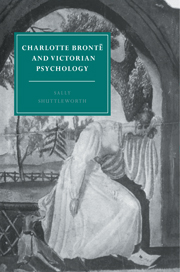Book contents
- Frontmatter
- Contents
- Acknowledgements
- Introduction
- PART ONE PSYCHOLOGICAL DISCOURSE IN THE VICTORIAN ERA
- 1 The art of surveillance
- 2 The Haworth context
- 3 Insanity and selfhood
- 4 Reading the mind: physiognomy and phrenology
- 5 The female bodily economy
- PART TWO CHARLOTTE BRONTË'S FICTION
- Conclusion
- Notes
- Index
- CAMBRIDGE STUDIES IN NINETEENTH-CENTURY LITERATURE AND CULTURE
4 - Reading the mind: physiognomy and phrenology
Published online by Cambridge University Press: 06 November 2009
- Frontmatter
- Contents
- Acknowledgements
- Introduction
- PART ONE PSYCHOLOGICAL DISCOURSE IN THE VICTORIAN ERA
- 1 The art of surveillance
- 2 The Haworth context
- 3 Insanity and selfhood
- 4 Reading the mind: physiognomy and phrenology
- 5 The female bodily economy
- PART TWO CHARLOTTE BRONTË'S FICTION
- Conclusion
- Notes
- Index
- CAMBRIDGE STUDIES IN NINETEENTH-CENTURY LITERATURE AND CULTURE
Summary
Brontë's fiction is permeated by the language and assumptions of phrenology. Her novels, as one critic has remarked, ‘contain passages of pure phrenological jargonese’. It is not, however, just in the explicit descriptions of cranial form and organs that one can trace the influence of phrenology, but also in the more widespread references to the development and exertion of mental faculties, a form of talking about the self as a collection of heterogeneous elements which was popularized by phrenology. On one of her trips to London Brontë paid a visit with her publisher, George Smith, to a phrenologist, who gave a surprisingly accurate diagnosis of his anonymous caller's character. Long before this time, however, we can trace her interest in phrenological ideas: Jane Moore is credited with possessing too large an organ of secretiveness in a story of 1838 (the Keighley Mechanics' Institute had acquired a Manual of Phrenology in the preceding year). Throughout her letters Brontë adopts a segmented view of the self, alluding to the contest of faculties, their individual recalcitrance, and the impact of well-developed organs on social behaviour: she describes Harriet Martineau's amused response to Joe Taylor's ‘organ of combativeness and contradiction’ and attributes Dr Arnold's success to his ‘giant faculty of labour’. Thackeray's writing suffers, in her judgment, when his ‘master-faculty’ of observation is ‘thrust into a subordinate position’. With reference to herself, Brontë, writing to Wordsworth, speaks of possessing in childhood, a ‘very strong faculty of admiration, but a very weak one of criticism’.
- Type
- Chapter
- Information
- Charlotte Brontë and Victorian Psychology , pp. 57 - 70Publisher: Cambridge University PressPrint publication year: 1996



